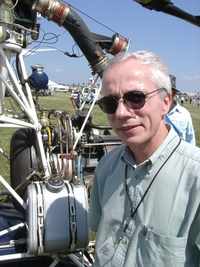 One of the niftiest machines
at Oshkosh this year is a little French helicopter, and it
flew over from France. It flew over, in the Airbus Beluga,
with 4 historic airplanes.
One of the niftiest machines
at Oshkosh this year is a little French helicopter, and it
flew over from France. It flew over, in the Airbus Beluga,
with 4 historic airplanes.
That having been said, it's one of the most-interesting concepts
and executions extant. One of about 150 made ("That was a
huge production run for the type, and for the time," its
owner reminded us), the diminutive DJINN helicopter may make
history during Oshkosh this year.
Its owner, French fighter pilot and test pilot Gerard
Guillaumaud (top), told us, "I bought it because it is what a
military pilot can afford... and for the history, but mostly
because it was in good condition, and affordable." He has learned a
lot about it since that time.
The Djinn weighs just 825 pounds empty, and double that weight,
grossed up; and it's jet-powered. It was the first turbine-powered
small helicopter in Europe, and probably the world, in production
(which started in 1954; this one's a '57).
Igor Sikorsky didn't think the drive concept would work, and was
quite public with that opinion at the time. It was
radical: there's no gearbox, no belts, and no tail rotor. Starting
at the back, there's no tail rotor because there's no torque to
overcome. There's no torque to overcome, and no belts, and no
gearbox, because this machine, featuring an Aeromeca Palouste IV
jet engine, has a very clever drive system.
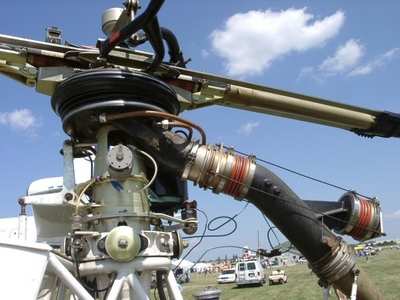
"Some other ideas had been tried -- like this -- already,"
Mr. Guillamaud reminded us. "Some had even little propeller engines
on the rotor tips; some had little jet engines. None of them worked
very well." This design is simpler.
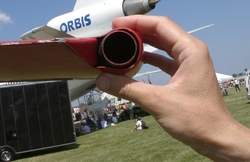 Here's how it works: the turbine
bleed air is routed through the rotor head (above), thence
into the fairly thick rotor blades. Once it's in there, it travels
down a smaller-diameter pipe to the rotor tips, where it is
expelled through a roughly 1.5" nozzle (right). That blast of
exhausted gas spins the rotor.
Here's how it works: the turbine
bleed air is routed through the rotor head (above), thence
into the fairly thick rotor blades. Once it's in there, it travels
down a smaller-diameter pipe to the rotor tips, where it is
expelled through a roughly 1.5" nozzle (right). That blast of
exhausted gas spins the rotor.
There are some advantages to this system: no gearbox, no tail
rotor, and no rear drive. Fewer parts, less complexity, lower
weight, and lower cost. Additionally, as Mr. Guillaumaud told us,
"The rotors are so heavy, there is so much momentum, that there is
only a very small 'dead-man zone' on this aircraft."
So, there's a rudder in the center of the horizontal stabilizer.
This is a helicopter that, on its best day, makes 75 mph. How does
that rudder work when it's hovering? "The downwash from the rotor,"
Gerard explained, "covers the tail, and it is in a predictable
path." That, plus a reasonable blast from the turbine's exhaust
itself ("Yes, it does provide a little thrust, too, but not much,"
Guillaumaud said) makes the rudder effective all the time.
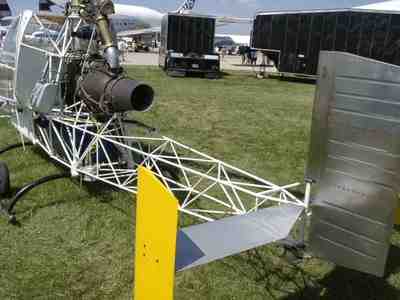
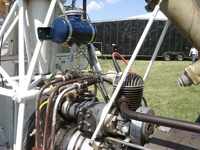 The only big thing about
this machine is the huge fuel tank, directly below the engine. It
holds 250 liters, good for about two hours' flight.
The only big thing about
this machine is the huge fuel tank, directly below the engine. It
holds 250 liters, good for about two hours' flight.
There's a smaller fuel tank, above the engine,
too. It holds one liter -- of 2-stroke gasoline premix. That's for
the little gas engine that is the starter. "You pull a cable in
here," Gerard showed us, as he reached for a handle that, on a
Cirrus, would trigger the 'chute, "and you start it like a chain
saw." That extra little engine led to some jokes. "They said it was
the first twin-engine helicopter in the French Army," Gerard
told us.
 ANN's Daily Aero-Linx (04.30.25)
ANN's Daily Aero-Linx (04.30.25) ANN FAQ: Turn On Post Notifications
ANN FAQ: Turn On Post Notifications Classic Aero-TV: Agile Aeros Jeff Greason--Disruptive Aerospace Innovations
Classic Aero-TV: Agile Aeros Jeff Greason--Disruptive Aerospace Innovations Aero-News: Quote of the Day (04.30.25)
Aero-News: Quote of the Day (04.30.25) ANN's Daily Aero-Term (04.30.25): Expedite
ANN's Daily Aero-Term (04.30.25): Expedite







